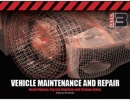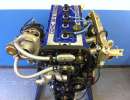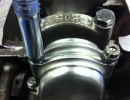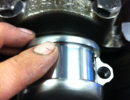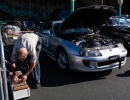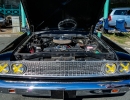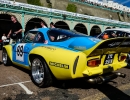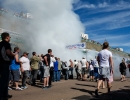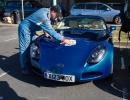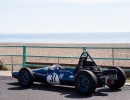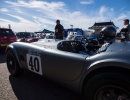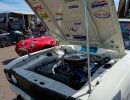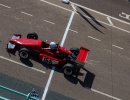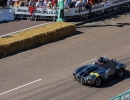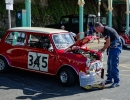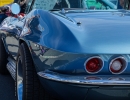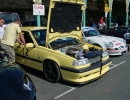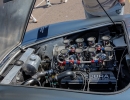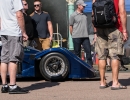Dimitri Cornet, Dimspeed, France
"I have used this brand for years and I never had any issues. I absolutely love to work this product and will never use something else to check clearances. Plastigauge is very easy, quick to use and clean. The clearance is so important in a race engine - Plastigauge is a very good quality product and a must have as an engine builder. I highly recommend Plastigauge."
Dimitri is a specialist in the restoration and preparation of racing vehicles, both vintage & modern. Dimitri has participated in in the Goodwood Revival, the six hours of SPA Classic, Mini Seven, Mini Miglia and Master Series. He has also worked as a track engineer on LMP1, which allowed him to participate in the 24 Hours of Le Mans.
www.dimspeed.com
Riteh Racing Team, May 2019
Plastigauge was delighted to offer our support to Riteh Racing Team, a Formula Student team from the Faculty of Engineering of the University of Rijeka, Croatia. The team was founded at the end of 2007 and consisted of only eight members. Today it is one of the largest and most successful student projects in Croatia. The team deals with designing, constructing and producing a prototype racing car with which to compete in global Formula Student competitions. The main goal of the project is to inspire young people to become the engineers of the future.
In 2019, Riteh Racing Team have been designing and building their fifth formula style prototype car with the purpose of educating and gaining experience. One of their priorities was to improve the overall engine performance and the team used Plastigauge to check their car's oil clearances.
BCoT Project MX5 2016
Plastigauge is proud to support the talented Vehicle Technology (Motorsport) students at Basingstoke College of Technology, who have launched a project to refit and race an MX5. Their goal is to raise £2000, which will get them the parts they need and cover the expense of some track days.
Although the second year students have had some racing experience with the College's MR2 Racing Team, this new project will give them the opportunity to prepare a vehicle to race, not just to maintain it.
Classic Bike magazine 2014
This article featuring the use of Plastigauge PL-A during a Honda CB400 Four engine rebuild appeared in Classic Bike magazine (Bauer Media) in October 2014. Words: Rick Parkington. Pics: Gary Freeman & Rick Parkington.
Dave Hobson, Automotive Tutor, Darlington College
"Plastigauge is very easy and quick to use, there is ample in the pack to complete the task and I would be confident that the results are as accurate as I need in modern day engine re-builds. I would be happy to teach my motor vehicle students how to use the product knowing that they may use it in the workplace."
Dave Hobson, Automotive tutor, Darlington College & co-author of Level 3 'Vehicle Maintenance & Repair' textbook
Piero Di Capite, Xpower Engines, Essex
"I wish to endorse my recommendation of this superb product Plastigauge.
Having built race engines for over 30 years I understand the need for a high level of accuracy - Plastigauge gives this. Despite having all the specialist tools at my disposal, I find Plastigauge quick and easy to use and very accurate.
Ideal for checking crank shaft bearing and cam cap clearances this product is a must have for all serious engine builders, with the added advantage for the 'hobby' mechanic of not having to go to the expense of buying specialist tools.
An excellent product produced by a company who give great, friendly service with fast despatch."
Piero Di Capite - Xpower Engines, Essex
Some of Piero's photos showing Plastigauge being used on a Ford Cosworth 2.0I Yb engine.
Ford Cosworth 2.0l Yb engine
A strip of Plastigauge is placed across the bearing surface before replacing the shell and tightening the set-screws to the recommended torque setting (without rotating the journal)
After removal of the shell, the clearance can be read by comparing the compressed Plastigauge with the calibrated measuring card. In this case, the clearance is 0.002" 
Engines in Xpower's Essex workshop 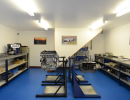
Archie Milligan, Motherwell
"I am re-building a classic 1979 Honda CB750 F2 and had to buy a second hand crank which came with perfect shells but the size not known as the colour coding has long washed off. I checked the clearances with Plastigauge which was incredibly easy to use and found all the shells to have a 2 thou clearance. Perfect.
New parts for these now obsolete engines are very expensive and for the price of a few pounds using Plastiguage, I have confirmed that the parts I have are not only the correct sizes, they are well within tolerance.
Many thanks for your technical help and excellent product."
Archie Milligan, Motherwell
Brighton Speeds Trials 2012
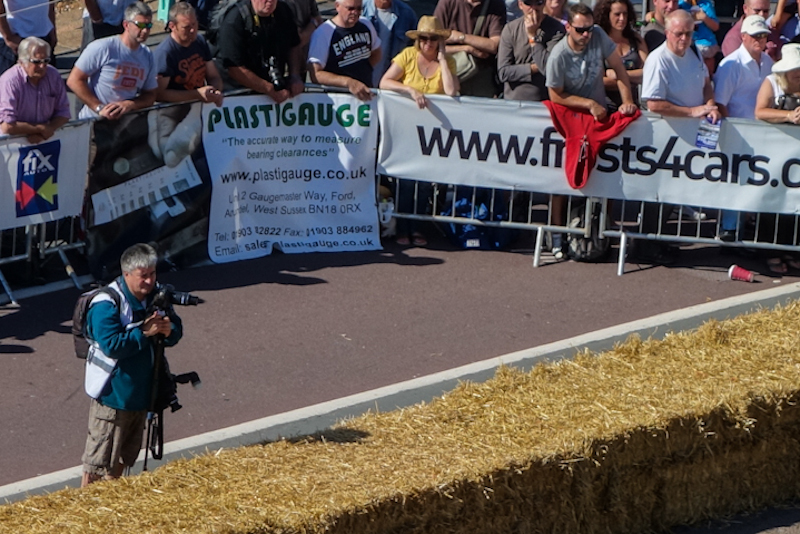
On Saturday 8th September the Plastigauge team headed down to Brighton seafront, just a short drive from our premises in Arundel, for the 107th annual Brighton Speed Trials. As a company we are proud to support this historic event which provides the opportunity for car and motorsport enthusiasts to indulge their passion on the sunny south coast at the oldest racing event of its kind in Europe!
This exciting and well-supported event is run each year by the Brighton and Hove Motor Club and sees a wide variety of classes of cars and motorcycles competing fiercely for the best times of the day. This year's record was a cool 154mph for the quarter mile sprint along Brighton's Madeira Drive.
This year thousands of spectators lined Brighton seafront in the glorious September sunshine for a glimpse of the fast-paced action as well as the opportunity to wander around the paddock, chatting to car and racing enthusiasts from around the country.
Both competitors and spectators will have been familiar with Plastigauge products which are widely used in both professional engine building and home rebuilds and which provides a crucial tool in ensuring correct oil clearances. It can be used for measuring clearance in both engine rods and main bearings. For more information on using Plastigauge in plain automotive bearings click here.
The Plastigauge team took many photos of this wonderful event which we are pleased to share with you below. We hope to see you there next year!
Toyota Supra
Bikes heading toward the start line, including a Kawasaki Z1000J
Ford Fairlane
One Ferrari F40 and two very lucky owners!
Alpine Renault A110
Maserati Monza
TVR Tuscan V8 Racer
First burn-out of the day on the start line!
TVR T350C
Alfa Romeo
Preparing for launch!
Cobras
Lamborghini Aventador LP700-4 - nice!
Dodge Buss Coupe
Ecurie Ecosse
Porsche 911S
AC Cobra Daytona
Kirkham 289 Mk11
Two track cars
Ford Escort Mexico
Ford Cortina
OMS RA racing across the finish line
Roadcraft Cobra
Spectators
Cobra ready at the start line and Brighton pier in the background
Lining up at the start line
Mallock MK 8 along with two other track day cars
In the Paddock
Morris Cooper S being worked on before the time trial
Fiat Balilla crossing the finish line
Corvette Stingray Convertible
Cantrac Ultima
Ford Fairlane, left, Mazda RX7, right
Porsche 911 RSR
Noble M12 GTO
Volvo 850 T5R
Sunbeam Alpine 1V
Cobra engine
Cobra
Lotus Europa heading to the start line
Track car tensed for launch
Classic Motorcycle Mechanics magazine 2011
This article appeared in Classic Motorcycle Mechanics magazine (UK) and Redaktion Oldtimer Praxis magazine (Germany) in July 2011.
Words and pics: Phillip Tooth – www.torquewrite.com
Shell out on new bearings
When this Honda 400/4 crankshaft needed new main and big end bearings we used Plastigauge to make sure that it would spin freely in the crankcase.
When your big ends start knocking and your footpegs start vibrating it’s time to strip your engine. The knocking is caused by excessive wear between the connecting rods and the crankshaft. Most modern four-strokes use plain big end bearings, which are also known as white metal bearings. These are made of replaceable steel shells, which are keyed to the bearing caps. The inner surface of the steel shell is plated with a coating of bronze, and this in turn is coated with a thin layer of Babbitt metal. The Babbit metal, which may be 90% tin with the remaining 10% a mixture of copper and antimony, is the bearing surface. It is easily scratched, so be careful how you handle plain bearing shells.
If there is too much clearance between the crank and the bearing surface, whether caused by wear or using the wrong size replacement bearing shells, the oil pump may not be able to deliver enough lubricant under high enough pressure. And if that happens, your bearings will fail again.
The normal oil clearance in a big end or main bearing is approximately one part in 2000 of the diameter (check the figure in your workshop manual) so if your crankshaft journal has a diameter of 40.00mm then there should be a clearance of approximately 0.02mm. The good news is that plain bearings are designed to be sacrificed to save the crankshaft journals and the connecting rod big ends. They are easy to replace, and come in a range of under-sizes to account for wear in the crankshaft journals. Here’s how we did replaced the crankshaft bearings in a Honda 400/4.
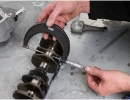 Dismantle engine and wash crankshaft with kerosene, then dry. Inspect the journals for scoring – light scoring can be removed with emery cloth – and measure the diameter with a micrometer.
Dismantle engine and wash crankshaft with kerosene, then dry. Inspect the journals for scoring – light scoring can be removed with emery cloth – and measure the diameter with a micrometer.
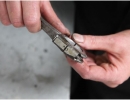 Connecting rods have 1, 2 or 3 engraved on the eye to indicate the outside diameter of the bearing, which is 35mm plus up to +0.024mm oversize to allow for variation in manufacture.
Connecting rods have 1, 2 or 3 engraved on the eye to indicate the outside diameter of the bearing, which is 35mm plus up to +0.024mm oversize to allow for variation in manufacture.
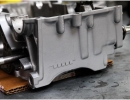 There are five crankshaft journals. Honda indicates the correct outside diameter of each main bearing by letters stamped on the rear lower half of crankcase, in this case BBABB.
There are five crankshaft journals. Honda indicates the correct outside diameter of each main bearing by letters stamped on the rear lower half of crankcase, in this case BBABB.
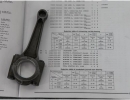 Honda parts book lists available bearings for crankshaft and big ends. Outside diameter does not change, but inside does. Undersize shells allow for up to -0.030mm wear.
Honda parts book lists available bearings for crankshaft and big ends. Outside diameter does not change, but inside does. Undersize shells allow for up to -0.030mm wear.
 The colour coded bearing shell has a tab to locate it in the groove in the bearing housing. Smear a drop of oil on the back of the shell before springing it into place.
The colour coded bearing shell has a tab to locate it in the groove in the bearing housing. Smear a drop of oil on the back of the shell before springing it into place.
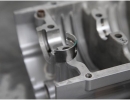 White metal shell bearings are pre-finished to give correct clearance. Under no circumstances should the bearing be scraped or the end cap joint faces filed.
White metal shell bearings are pre-finished to give correct clearance. Under no circumstances should the bearing be scraped or the end cap joint faces filed.
 The part number stamped on the outside of the bearing shell does not indicate the size – for that you need to look at the colour code. The hole lines up with oil feed in the crankcase. Your micrometer reading will indicate which size of replacement big end shells you will need. Always keep the rod and cap as a pair, and refit to their original journals.
The part number stamped on the outside of the bearing shell does not indicate the size – for that you need to look at the colour code. The hole lines up with oil feed in the crankcase. Your micrometer reading will indicate which size of replacement big end shells you will need. Always keep the rod and cap as a pair, and refit to their original journals.
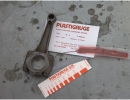 Cut a length of Plastigauge and lay width-ways on the journal. Assemble big end bearing, making sure nuts and bolts are clean and lightly oiled for an accurate torque reading.
Cut a length of Plastigauge and lay width-ways on the journal. Assemble big end bearing, making sure nuts and bolts are clean and lightly oiled for an accurate torque reading.
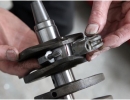 Finger-tighten the big end nuts and bolts and then use a torque wrench, tightening one turn at a time, to the correct torque figure given in the handbook.
Finger-tighten the big end nuts and bolts and then use a torque wrench, tightening one turn at a time, to the correct torque figure given in the handbook.
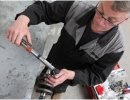 Take care not to turn the rod or the crank as it will smear the Plastigauge and give a false reading. Carefully remove the big end assembly to reveal the squashed Plastigauge.
Take care not to turn the rod or the crank as it will smear the Plastigauge and give a false reading. Carefully remove the big end assembly to reveal the squashed Plastigauge.
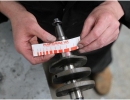 Match the width of squashed Plastigauge to the calibrated bars on the gauge provided in the kit (one side in fractions of an inch, the other in metric). We have 0.038mm clearance.
Match the width of squashed Plastigauge to the calibrated bars on the gauge provided in the kit (one side in fractions of an inch, the other in metric). We have 0.038mm clearance.
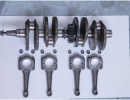 A Honda crank has production tolerances of between 0.018 and 0.048mm bearing clearance. Maximum wear of 0.08mm is corrected by undersize bearings. Our crank is within limits.
A Honda crank has production tolerances of between 0.018 and 0.048mm bearing clearance. Maximum wear of 0.08mm is corrected by undersize bearings. Our crank is within limits.
The product used in this article is Plastigauge PL-A
With thanks to Ashley - www.classicbikerestorations.net
Squeeze me!
You can’t stick a feeler gauge between a big end bearing and the crankshaft journal to measure the oil clearance. So what do you do? Like all brilliant ideas, the principle behind Plastigauge is simple – the tighter you squeeze a cylinder of soft plastic material, the thinner it gets and the more it spreads. If you know the diameter of the cylinder at the start, and how wide it spreads, you can work out how thick the compressed material is and so measure the clearance between two surfaces. Different Plastigauge kits measure clearances from between 0.018mm – 0.045mm right up to 0.025mm – 1.75mm.
Handle the Plastigauge material carefully, use a sharp knife to cut a piece the width of the journal and hold it in place with a smear of grease. The manufacturer recommends putting a smear of silicone release agent on the shell. You can check a journal has not worn oval by placing four pieces of Plastigauge around the journal and comparing the readings. The squashed Plastigauge can be removed with a clean oily cloth or a de-greasing solvent. Plastigauge is soluble in oil, so any small pieces left behind should not harm the engine in any way.
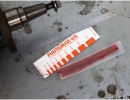 Besides measuring the clearance between main bearing or big end shells and crankshaft journals, you can also use Plastigauge to measure the clearance between the camshaft and bearing surfaces, or high spots between cylinder heads and barrels. If you can’t use a feeler gauge, try a Plastigauge
Besides measuring the clearance between main bearing or big end shells and crankshaft journals, you can also use Plastigauge to measure the clearance between the camshaft and bearing surfaces, or high spots between cylinder heads and barrels. If you can’t use a feeler gauge, try a Plastigauge






